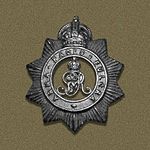- North Somerset Yeomanry
-
North Somerset Yeomanry 
Badge of the North Somerset YeomanryActive 1798–present Country Great Britain Branch Army Type Yeomanry Size Regiment Part of Royal Armoured Corps
Royal SignalsThe North Somerset Yeomanry was first raised in Frome in 1798. A condition of service was that it should not be required to march more than 10 miles from the town and it was soon disbanded in 1802. The Frome Troop was re-raised in 1803 and united with The East Mendip Corps in 1804, this new Yeomanry Regiment being designated the North Somerset Yeomanry Cavalry in 1814.
The Yeomanry were a select corps, with members accepted only on the recommendation of one or more serving members and usually paying an entrance fee. Their main employment in the early 19th Century was the suppression of riots, such as among miners in Radstock in 1817 and among weavers in Frome in 1822.
Contents
Boer War
During the Boer War it became part of the 7th Battalion of the Imperial Yeomanry. The Regiment was renamed Dragoons in 1908, and went to France during World War I in that role.[1]
World War One
During World War One the Regiment was expanded to three regiments: the 1/1st, 2/1st and the 3/1st.
1/1st North Somerset Yeomanry
The 1/1st was formed in 1914 in the city of Bath and become part of the South Western Mounted Brigade. In October 1914 it was moved to France and joined the 6th Cavalry Brigade, 3rd Cavalry Division.[2]
In March 1918 it left the Division to be converted to a cyclist unit. This was changed to a machine-gun unit, but a hurried decision was taken (during the great German Spring Offensive) to keep the Regiment as a mounted unit, whereupon it became Cavalry Corps troops. Then in April 1918, the Regiment was broken up, supplying reinforcements to the other units of the 6th Cavalry Brigade in 3rd Cavalry Division.[3]
2/1st North Somerset Yeomanry
The 2/1st was formed in September 1914 and remained in the United Kingdom until early 1918 when it moved to Ireland and was converted into a cyclist unit.[4]
3/1st North Somerset Yeomanry
The 3/1st was formed in 1915 and remained in United Kingdom until absorbed into 6th Reserve Cavalry Regiment in early 1917.[5]
World War two
During World War II, the Regiment was first employed in the Far East, then fought in Syria, and in 1943 was converted to the Royal Corps of Signals unit. As Air Formation Signals it served in the Western Desert, Sicily, Italy, and North West Europe.
Post war
After the War the Regiment became the Armoured Regiment of 16th Airborne Division and joined with the 44th Royal Tank Regiment to become The North Somerset and Bristol Yeomanry in 1956. Although the Regular battalions of the Somerset Light Infantry and the Duke of Cornwall's Light Infantry merged to become the Somerset and Cornwall Light Infantry in 1959, the Territorial battalions kept their county names. In 1967, the Territorial battalion (Somerset Light Infantry (TA)) and elements of the North Somerset Yeomanry and West Somerset Yeomanry merged to form the Somerset Yeomanry and Light Infantry, which changed title again in 1971 to become the 6th Battalion The Light Infantry (Volunteers).
In 1969, when the complete disbandment of the Territorial Army was being considered, it was reduced to a cadre of eight men, as was the Duke of Cornwall's Light Infantry (TA).[6]
39 (Skinners) Signal Regiment (Volunteers)
The North Somerset Yeomanry was reformed as the Headquarters Squadron of 39 (Skinners) Signal Regiment in 2000 and, from 2008, the squadron became the regiment's Support Squadron. The regiment is now consists of the following elements.
- Regimental Headquarters - Bristol
- 56 Signal Squadron (Volunteers), [Eastbourne]
- 57 (City and County of Bristol) Signal Squadron (Volunteers) , [Bristol]
- 93 (North Somerset Yeomanry) Support Squadron, [Bristol]
- 94 (Berkshire Yeomanry) Signal Squadron, [Windsor]
References
- ^ "lightinfantry.org". http://www.lightinfantry.org.uk/regiments/six/6th_index.htm.
- ^ "warpath.orbat". http://www.warpath.orbat.com/cav/3_cav_div.htm.
- ^ "warpath.orbat". http://www.warpath.orbat.com/cav/3_cav_div.htm.
- ^ "warpath.orbat". http://www.warpath.orbat.com/cav/3_cav_div.htm.
- ^ "warpath.orbat". http://www.warpath.orbat.com/cav/3_cav_div.htm.
- ^ "lightinfantry.org". http://www.lightinfantry.org.uk/regiments/six/6th_index.htm.
Categories:- Yeomanry regiments of the British Army
- Regiments of the British Army
- Military history of Somerset
Wikimedia Foundation. 2010.
